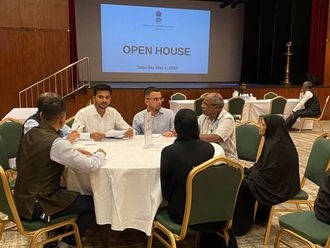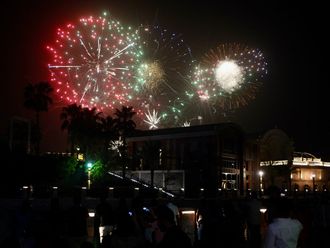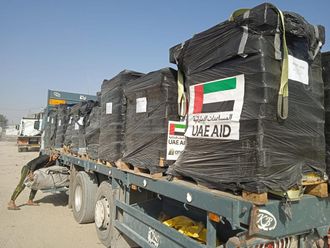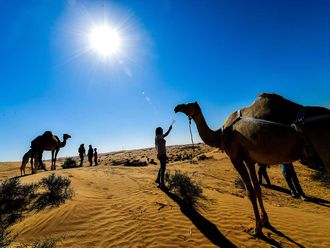Fifty-two years after men first conquered Mt Everest, two Iranian women became the first Muslim women to scale the peak. Sudeshna Sarkar spoke to them in Kathmandu
When Laleh Keshavarz got married in December 2004, her way of celebrating the happiness of having arrived at this new milestone in her life was to mark out another milestone for herself.
| Gulf News Iranian women mountaineers prove to be no strangers to the world's most demanding peak. |
She decided to scale the highest mountain peak in the world – Mt Everest.
On May 30 this year, Keshavarz, a 25-year-old dentist from Zahedan in southern Iran, along with Farkhondeh Sadegh, 36, a Tehran-based graphic designer, became the first Iranian women – indeed, the first Muslim women – to conquer the mountain.
What drove the petite, soft-spoken Keshavarz to undertake this most unusual decision? A desire to keep a date with history.
It all began last year when the Iran Mountaineering Federation (IMF) decided to send an expedition to Mt Everest, known as Mt Sagarmatha in Nepal and Mt Chomolungma in Tibet.
Iranian mountaineers are no strangers to this most demanding peak in the world.
In May 1998, an expedition from this Islamic nation reached the summit.
However, what made the IMF's announcement so exciting was the fact that it had decided, for the first time, to send a team of women climbers as well.
Though Sir Edmund Hillary and Tenzing Sherpa Norgay scaled Mt Everest in 1953, it took another 22 years before the first woman climber – Junko Tabei of Japan – to match their feat.
While over 1,500 men have joined the Everesteers' club since Hillary's feat, only about 100 women had taken up the challenge so far. And none were from an Islamic country.
Flood of entries
It was perhaps to set this imbalance right that the IMF's invitation to women climbers attracted a barrage of applications.
There were 69 women applicants, of whom 14 were shortlisted after weeks of gruelling fitness tests on the slopes of mountains in Iran. More tests and interviews later, the number
of shortlisted candidates was whittled down to 7.
Sadegh, who has four sisters and has been an avid climber for over a decade, was selected to lead the team.
| From left: Laleh Keshavarz, Parvin Rezayi, Rezvan Salmasi, Farkhondeh Sadegh and Nasrin Nemati. |
Only three of the seven are married.
"People, especially Westerners, think Muslim women don't go to work but simply stay at home and cook, wash and take care of their children," says Sadegh.
"We work; we have lots of job responsibilities. Most of [the women] study in universities. In fact, today, 65 per cent of university students in Iran are women. We hold important jobs, we are in parliament and have voting rights, too. We can do everything we want to."
But despite it all, they still respect their religion: while attempting to scale Mt Everest, all seven climbers wore their headscarves beneath their balaclavas.
In fact, Bahrami insisted that her headscarf be firmly in place even when she was lying in bed surrounded by oxygen tubes and nasal drips after she was admitted to Norvic Hospital in Kathmandu to treat a blood vessel rupture in her brain caused by oxygen deficiency.
The seven women were part of a team of 21 led by Sadegh Aghajani and included a still photographer and a video cameraman.
The Iranian 2005 Everest Expedition went up the mountain via Nepal, or the southern way, a route that was dogged by bad weather most of May.
"You can't reach the top in one go," Keshavarz explains for the benefit of the uninitiated.
"First, there is the base camp at 5,300 metres. Then there are four more camps before you reach the 8,848-metre summit. You climb up a little, then come down to [the camp] for rest and to take shelter from bad weather and, more importantly, to get acclimatised to the high altitude where oxygen becomes rare and can pose difficulties in breathing."
This year, the weather was exceptionally bad with gusty winds and surprise avalanches that flattened tents and created havoc during the climb.
Luckily, no one was killed by the avalanches.
Sadegh recalls witnessing one avalanche. The team was in Camp 1 when it occurred.
"We have seen a lot of strange things. The avalanche ... flattened our tent as well as the tents
of several other climbers. But we all helped one another and in two hours we had repitched a tent for those who were going to begin the climb to the summit."
Though the team reached the base camp on April 22, they had to wait for over a month before the weather finally cleared and on May 30, a "window" opened allowing 8 members to make it to the top.
The day of the triumph is indelibly etched in the minds of the women. It was a glorious Monday morning and 46 climbers in 9 different teams were heading up the mountain.
Twelve members of the Iranian expedition reached the summit, including four Sherpas from Nepal who were acting as their high-altitude guides and porters.
The Iranian summiteers were Eghbal Aflaky Aghbelagh, 51; Mahmed Shoaei, 43, an engineer; Azim Ghechisaz, 24; Reza Bahadorani, a 27-year-old jewellery seller and Sadegh and Keshavarz. Later, a second group in the team succeeded in sending two more members up – Reza Zarei Toudeshici and Jalal Cheshmeh Ghasabani.
"Both of us went up to the summit together," says Sadegh, describing the experience of a lifetime.
"We were so excited we didn't have words to describe our feelings. When we neared the peak, during the last hour, I could not even think. I simply concentrated on walking forward because I had to [make it to the summit]."
And when they proudly planted the flag of Iran in the snow at the top of the world, it was a moment of unparalleled jubilation.
"Of course, God helped us," says Sadegh.
"He gave us four days of good weather and we succeeded on the first day. Laleh and I hugged each other and then we started crying. We cried a lot and loudly. And when we radioed our friends at the base camp to tell them we had done it, they started crying too. Everyone was crying."
The entire team revelled in their achievement.
"We were proud of our attempt," Sadegh c












